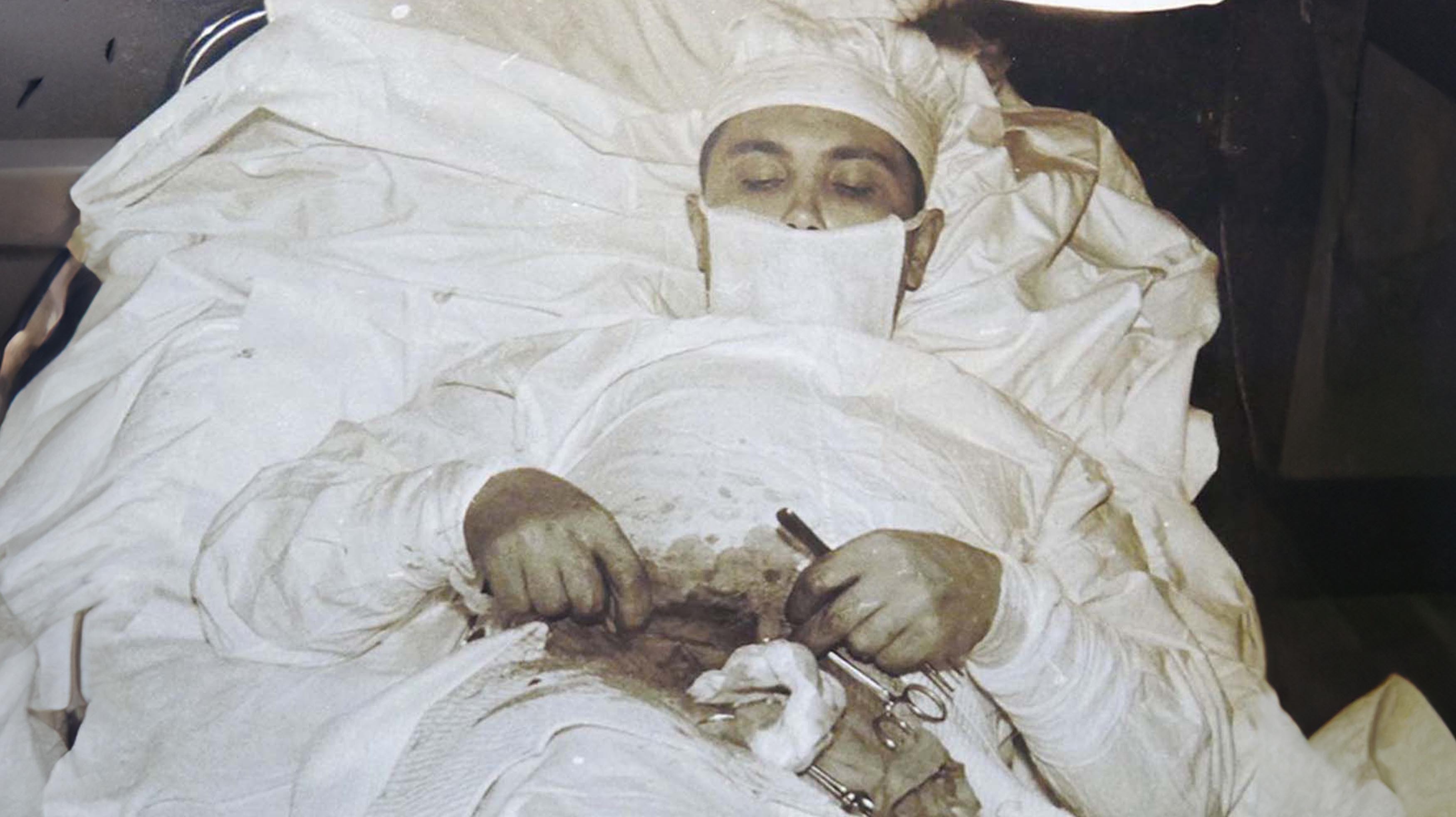Self Surgery: Leonid Rogozov Removed His Own Appendix
Imagine the moment you’re holding a scalpel over your own skin, knowing you need to cut into yourself in order to save your life. Leonid Rogozov was doctor who was a novice at surgery, but found himself needing to do exactly that in order to survive. In this episode, we talk about self-surgery and tell the story of the man who performed his own appendectomy while stranded at an Antarctic Research Station. Then we play the quiz game with Glen Tickle, who just completed a comedy tour of Hungary.

Imagine the moment that you’re holding a blade above your skin, about to cut into it in order to save your own life.
There are only a few circumstances where someone would be drawn to perform surgery on themself: the first one would be some sort of rare psychological disorder that would cause someone to mutilate themselves. We’re talking about something very different than cutting or self-harm. In the case of the very rare body integrity disorder, people have been known to actually want to amputate their own limbs…some have even carried through with it.
But then there’s the case of medically necessary surgery. The only situation you’d ever want to do it to yourself is in a dire circumstance where getting to a hospital isn’t an option. Or perhaps someone might choose to do so to avoid medical expenses, or laws. In all of these cases, self-surgery is an extreme last resort and incredibly rare.
Our story today is about one such case – the story of Leonid Rogozov. His story is probably the most popular of all of the tales we have about people doing surgery on themselves.
There’s a story from 1920 where a German doctor had heard about the idea of reaching a horse heart through a jugular vein – known as catheterization. It hadn’t been done on a human, so he did it to himself. The funny story here is that he wanted to do it to a patient. The chief of surgery said no, so he asked if he could do it to himself. The chief still said no, so he secretly recruited an operating room nurse to help him do it anyway. He needed her permission to use the room. She volunteered to be the patient, but he still wanted to do it on himself. So he said yes to her, just so he could use the room. He anesthetized her and told her she would be the patient. Then he just did it to himself. He was successful in reaching the heart with the catheter and became the first to do so.
Sometimes the person doing the surgery isn’t a surgeon, but has to do it in order to survive. This was the case with hiker Aron Ralston. In 2003, he was exploring a canyon and a boulder above him came lose, trapping him to the rock wall by his right arm. He had no way to contact anyone for help because his phone didn’t have a signal down in the canyon. He knew that if he didn’t free himself, he would die of starvation. So he reached his left arm into his pocket and retrieved a pocket knife. The rest of the story is told in the Danny Boyle film 127 Hours, but you can imagine what he did. He had to cut through the skin, muscle and tendons, twisting and breaking his own bones with no anesthesia. He was able to amputate his own arm and climb the remaining 65 feet to safety.
And in the case of today’s story, the story of Leonid Rogozov, it’s a combination of surgical know-how and survival. Because in 1961, he found himself in a dangerous situation.
Leonid Rogozov was trained in pediatrics and became licensed in the Soviet Union as a General Practitioner in 1959. It was then that he began to study for what he really wanted to do – surgery. So at the age of 25, he started his clinical surgery training, but only got a year into it before an opportunity for work showed up.
In 1960, at the age of 26, he was asked to join the sixth Soviet Antarctic Expedition as their doctor. He had his general practitioner training and that was enough to be more than able to serve as the expeditionary doctor for a team of 13 researchers on their trip.
Their mission was to head to the Novolazarevskaya Station in Antarctica, 5,500 miles from where he graduated medical school in Saint Petersburg, Russia. They would leave as the polar winter came over Antarctica in 1961. The remote research station had only just been established in February and the job of this group of 13 was to reach the station and see it through the harsh winter months. The harsh weather wouldn’t allow for a flight, so the group had to travel to Antarctica by sea. It took the group 36 days to get to Novolazarevskaya. Once there, they would be 1,000 miles from the next nearest Soviet research station. It was truly a remote location, but the 13 researchers made it successfully.
Everything was going smoothly until late April of 1961. On the morning of April 29, Leonid Rogozov woke up with a stinging pain in his abdomen that moved toward the lower right side. That symptom, along with the weakness, nausea and fatigue he was experiencing made it clear to the medically educated man what was happening. He was suffering from peritonitis, most likely from an appendix that had either ruptured, or was about to rupture at any minute.
Rogozov hadn’t ruled out more conservative options. He considered them, but he knew that none of them would have helped. There was already infection happening inside his body and the appendix absolutely had to be removed if he wanted to survive. The crew began contacting other research stations run by other countries, but no one had an aircraft available, and even if they did, the weather conditions outside would have prevented safe flying. The nearest Soviet station was Mirny, which was 1,000 miles away. The ship that had brought them wouldn’t be back for another year. He was out of options. It was remove the appendix, or die.
The idea of removing one’s own appendix wasn’t new. According to a report by the National Institute of Health, it was first attempted in 1912 by American Surgeon Bertram Alden, who was forced to end the procedure when his assistant threatened to leave. It was successfully accomplished by another American surgeon, Evan O’Neil Kane, in 1921. After his successful self-surgery, Kane boldly wrote “I wish to emphasize my statement that any surgeons, if not obese, can, with perfect ease and even comfort, self-operate in cases such as mine.”
Whether or not Leonid Rogozov had researched these cases or not remains unknown, but he made the decision to move forward with the surgery on May 1st. Thanks to a journal he kept, we know what he was thinking at the time. Rogozov wrote the following:
“I did not sleep at all last night. It hurts like the devil! A snow storm whipping through my soul, wailing like 100 jackals…Still no obvious symptoms that perforation is imminent, but an oppressive feeling of foreboding hangs over me… This is it… I have to think through the only possible way out – to operate on myself… It’s almost impossible… but I can’t just fold my arms and give up.”
Before going forward with the surgery, it was important that the entire thing be approved by their commander in Moscow. This was 1961, a time when tensions between Russia and the West were at a high, and every little news story about failure could cause national embarrassment for the Soviets. The decision was made that the surgery would happen.
Rogozov recruited two of his fellow expeditioners to help him out. The team’s driver and meteorologist. They would aide in handing him instruments, holding a lamp and a mirror. Another member stood watch in the room in case anyone passed out or additional hands were needed. The tools were sterilized by putting them outside in the freezing cold, with unsurvivable temperatures, well-below zero.
Rogozov had to find the right reclining posture to be able to be most effective. What he decided was that if he were in a semi-reclining position, with the upper half of his body upright and tilted slightly to his left, he would have the best opportunity to see what he was doing. His only anesthesia was a 0.5% solution of novocaine injected into the abdominal wall. The helpers watched as Rogozov cut an incision into his abdomen. Not being able to see properly, he accidentally cut too far and cut into his intestine, which he had to suture before continuing. Once the repair was done, he finally was able to see the appendix. He reported it as having a dark stain at its base and concluded that it wasn’t ruptured, but would have within the next day. He felt bad for his assistants. In his journal, he wrote, “My poor assistants! At the last minute I looked over at them. They stood there in their surgical whites, whiter than white themselves. I was scared too. But when I picked up the needle with the novocaine and gave myself the first injection, somehow I automatically switched into operating mode, and from that point on I didn’t notice anything else.”
The idea of using a mirror was a good one, but it threw him off with everything being mirror image. So he decided instead to work by feel alone, removing his gloves. As the surgery went on, Rogozov grew weak and dizzy and began needing to take 20 minute breaks just to keep himself from passing out. The bleeding was heavy. After 2 hours, the surgery was done. The appendix had been successfully removed and he sewed the final stitches in his abdomen. He wouldn’t know if it had been a success until he fully recovered over the next days. And this part is amazing. After 5 days, his symptoms were gone. No more fever. After 7 days, he removed his stitches. Two weeks later, Rogozov was back on his feet, resuming his normal duties tending to the needs of the other researchers.
This was ground breaking, and one of the reasons it became so widely known is because of Rogozov’s meticulous journal entries, detailing every step. There’s also the fact that his fellow expeditioners took photos of the entire process. So we have a very detailed and accurate account of everything that took place. Again – this was a time in which exhibitions of toughness and ingenuity went a long way to capture the imagination of the Soviet Union and was viewed on a world stage.
Later that year, Rogozov was recognized for his courage and awarded the Order of the Red Banner of Labour, which was at the time the 3rd highest award that a Soviet civilian could be given. The surgery also resulted in a change to policy on long expeditions like these. Future researchers would undergo medical testing to ensure their fitness before undertaking long expeditions.
Leonid Rogozov lived until 2000, dying at the age of 66 from lung cancer. His story of resilience, self-reliance and fortitude lives on. The Internet Says it’s True.

Watch Glen’s special, “Glen Tickle Against the World Crime League” at https://www.youtube.com/watch?v=Uh2WRWwrMnE
To listen to the NPR Episode about hookworms referenced in this episode, go to https://www.thisamericanlife.org/404/enemy-camp-2010/act-three-0?fbclid=IwAR1JA2f9ZdMdsOCEcma5DDCCVOymx8ma6KJr0AxnGUOSjlaBghMxFpQtuqg
Review this podcast at https://podcasts.apple.com/us/podcast/the-internet-says-it-s-true/id1530853589
Bonus episodes and content available at http://Patreon.com/MichaelKent
For special discounts and links to our sponsors, visit http://theinternetsaysitstrue.com/deals

